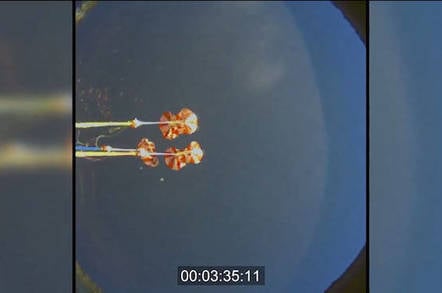Purple glistening plasma, you say? Orion plummets back to Earth
*Cough* A 'naut's view. *Cough*

Vid NASA has released video images of its Orion spaceship as it re-entered Earth's atmosphere earlier this month.
It shows the view that astronauts might eventually see if the US space agency's mission to send human beings to Mars in 2021 proves successful.
On 5 December, Orion flew unmanned this time. In order to gather as much data as possible about its first flight, NASA fitted it with 1,200 sensors both inside the cabin, and throughout the spacecraft.
The capsule was also fitted with cameras, which captured images of the 4.5-hour flight test, during which time the 'craft took in two elliptical orbits of Earth, with a high altitude point of 3,604 miles, a pass through the lower Van Allen belt, atmospheric re-entry at 20,000 miles an hour and 4,000 degrees Fahrenheit, and an eleven-parachute deployment landing system to finish up drifting gently down to the sea.
NASA said of the vid:
The last 10 minutes of Orion’s flight test show the plunge through Earth’s atmosphere, when searing plasma so hot it appears purple (upper left) surrounds Orion.
A few minutes later you can witness the jettison of the forward bay cover, followed by the release of the drogue chutes and then the main chutes (lower left). It’s all right there before your eyes just as it happened on Orion and how future astronauts will see it when they return from deep space missions and one day coming home from Mars.
®








 User Center
User Center My Training Class
My Training Class Feedback
Feedback











